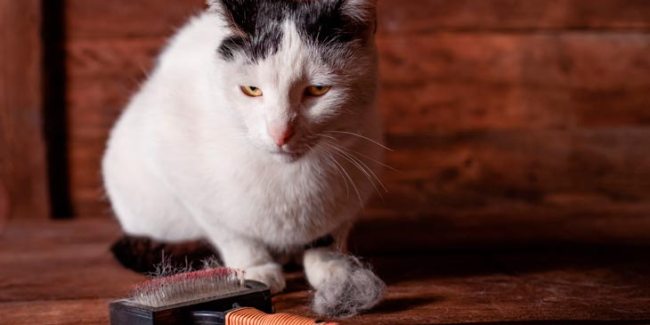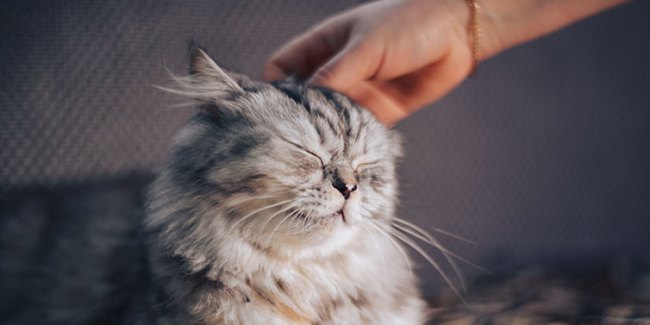Cat Weight Loss: How Monitoring Meals Can Help Tackle Feline Obesity
You might think that a fat cat is simply adorable but, just like in people, being overweight or obese can lead to a wide variety of health complications. It’s important to regulate your cat’s caloric intake and make sure they’re getting enough exercise so that you can spend many long and happy years together. Read on to learn more about cat weight loss.
CAT TIPS AND TRICKS

Posted by bravectosouthafrica – 29 April 2020
Signs and Symptoms of an Overweight Cat
You may think that your precious feline friend is merely fluffy, not fat. However, even moderate obesity can have a serious negative impact on your cat’s overall quality of life. Being overweight or obese can lead to your cat developing a wide variety of health issues. This reduces their
quality of life and may even lead to an early demise. Numerous areas of your cat’s body are affected by excessive body fat, including their bones, digestive organs, joints and organs relating to their breathing capacity, to name but a few.
Some felines are more prone to struggling with excessive weight gain. Cats especially at risk of becoming overweight or obese are those who are middle-aged (between 5-10 years old), neutered or primarily resides indoors. A lack of exercise or a change in metabolism makes indoor and neutered cats the most likely to develop unhealthy weight gain.
Tell-tale signs and symptoms of obesity in cats include:
- A bulge on both sides of the base of their tail
- A rounded abdomen
- Achieving an above-ideal score during a body condition assessment
- An inability or unwillingness to exercise
- Being unable to feel their ribs or spine when stroking them
- The lack of a clearly defined waist when viewing your cat from above
- Visible fat deposits across the body

Most Common Causes of Feline Obesity
There are many possible causes of obesity in cats. Some may eat too much simply because food is constantly available. There are cats out there who are able to control their own food consumption – who’ll stop eating when they’re full. Others will continue feeding until all available food has been devoured, even if they aren’t feeling hungry anymore. That’s probably the most common cause of weight gain: an imbalance between the amount of energy consumed and the amount of energy actually used.
Those who own more than one cat will know to what great lengths a foodie feline will go to try and sneak the other household cats’ share of food. They may even resort to downright bullying.
The opposite is also true. Some cats may overeat for fear of their food being stolen by other household pets. Past trauma, such as during kitten hood, can also contribute to your kitty feeling anxious about the availability of food later on.
Another possible cause of your cat’s excessive eating is that they just really enjoy their food that much. They don’t want to stop eating, even when they’re tummies are technically full and satisfied.
Old age may also be the cause of an overweight cat. As they age their ability to exercise as much as they used to gradually declines. Feline obesity can be brought on by unhealthy eating habits too, such as:
- Feeding your cat high-calorie food
- Frequently alternating their diet
- Giving them too many treats
Pre-existing medical conditions, as well as the use of certain medications, can also lead to your kitty’s rapid weight gain. Medical conditions include:
- Hypothyroidism
- Insulinoma
- Hyperadrenocorticism

Diagnosing Obesity in Cats
The only accurate way to determine if your cat is truly obese is by having your trusted vet look them over. A physical exam will take place, during which your vet will palpate your cat’s head, lumbar region, ribs and tail to assess their body composition. The results of this examination will then be compared to the specific breed standard that best matches your cat.
A body condition scoring system will finally reveal whether or not your cat qualifies as underweight, healthy, overweight or obese. Your vet will either use a 1-5 point scale or 1-9 point scale to determine where your cat’s weight lies. If your cat’s body weight is in excess of 10-15%, then they will be diagnosed as obese. Cats who score more than seven on the nine-point scale are deemed obese.
Your vet may also recommend further diagnostic testing, that includes blood work, so that underlying medical conditions can either be identified or ruled out (e.g. an under active thyroid). Be sure to disclose your cat’s medical history, medications and diet if you’re visiting a new vet for the first time.

Cat Weight Loss Plans
Once the exact nature of your feline friend’s obesity has been discovered, your vet will explore various cat weight loss options. As always, their decision on how to proceed will be based on your cat’s best interests and you should follow your vet’s care instructions to a T.
Once you’ve started your cat on their recommended weight loss plan, be sure to check in with your vet frequently to monitor their progress. This is extremely important, as losing too much weight too fast is also dangerous.
Cat weight loss will usually boil down to making changes in three key areas: diet, exercise and medication. We’ll be looking at diet a little closer.
The Importance of a Controlled Diet
One of the first steps in turning an overweight cat back into a fit feline is making adjustments to their diet. Your vet’s weight loss program will focus on keeping track of both your cat’s food intake and weight. Certain nutritional products recommended by your vet may also aid in the weight loss process.
Please note that you shouldn’t abruptly reduce the volume of food you feed your cat, as this can lead to future malnutrition. Successful cat weight loss, like human weight loss, is a gradual process that should take place on a controlled basis.
One change that can help you see results is by starting your cat on a feeding schedule. You’ll typically feed your cat twice daily – once in the morning and once in the evening – at times that best suit your schedule.
When meal feeding, provide your cat with their vet recommended portion and wait 30 minutes, then remove their bowl. They should adapt quickly to their new routine.
“[Cats will] protest at first, but they’ll adjust. It’s much healthier to meal feed them.” – Dr Nicole Uranko, Chief of Staff at Pleasant Valley Animal Hospital
The pros of meal feeding your cat far outweigh the cons. Sticking to a set feeding schedule is beneficial because:
It Helps You Monitor Food Intake More Closely
This is especially helpful if you own multiple cats. Now you’ll be able to give the correct portion to the correct cat and can prevent them from eating each other’s meals. Place their bowls in separate areas and monitor them during their set feeding time to ensure no bullying is taking place between your overweight cat and its siblings.
Your cat is likely to be quite upset about this in the beginning, but don’t cave – you’re doing it for the good of their health! Speak to your vet about the possibility of providing healthy treats in-between meals.
Also, don’t be too worried if your cat doesn’t finish their whole meal within their allotted time. They’ll have mealtime again at dinner or tomorrow’s breakfast.
It Allows You to Observe Your Cat’s Normal Eating Habits
Knowing what’s considered normal for all your cats’ eating habits is important – you’ll be able to catch any developing issues early on. Monitoring your cats during mealtime will alert you to:
- Appetite changes (increase or decrease)
- Bad appetite
- Eating too fast
- Food aggression
- Reaction to new food (interest or disinterest)
It’s especially important for you to know what your cats’ eating habits are like if they’re on a
special diet or need to take medicine mixed in with their food.
A Set Meal Schedule Can Make Administering Medication Easier
Does your cat need to be medicated daily? Having set meal times make it easy to mix in their medicine with their food, ensuring they consume it all. However, should their keen sense of smell tip them off, you may want to talk to your vet about getting the same medication in another form (i.e. a flavoured liquid).
Your vet might even be able to recommend an alternative food or treat you can mix your cat’s medication into without them noticing.
Please remember to always consult with your vet before making any changes to your cat’s feeding schedule, food type or amount.

Making Sure Your Cat’s Weight Loss Was a Success: Keeping Your Cat Happy and Healthy Throughout Their Life
When dealing with cat weight loss it’s important to keep in mind that the process is a gradual one. Your cat’s entire weight loss journey can take more than a year to complete. Because you see your cat on a daily basis, you may not notice the real progress your cat is making. This is why it’s important to check in with your vet on a frequent basis: to accurately keep track of the progress your cat is making.
Once your previously overweight cat has reached their goal weight, you’ll want to focus on maintaining that weight. Relapsing is a real danger if you stop managing your cat’s portion control and activity levels. Don’t fall back on bad habits – always keep your cat’s best interests at heart.
Now that you know how to get your cat to lose weight, you’ll also want to look into keeping them free of nasty external parasites to further keep them in tip-top condition! That’s where Bravecto® comes in.
Bravecto® Spot-On for Cats is fast-acting and long-lasting – keeping your cat protected against ticks, fleas and ear mites for 3 whole months, all in a single dose! It’s convenient and easy to apply too: simply part the fur at the back of your cat’s neck and dab on the treatment using the Twist&’n’Use™ applicator.
At Bravecto® we always care about your pet’s health and well being.
Subscribe to our Newsletter
Get to know your furry friend better! Sign up for all things dog- or cat-related.
The Hairy Facts about the dreaded hairball
12 April 2021
Help! My dog’s barking mad! Volume 2
12 April 2021
Your Itchy, Scratchy Cat – All About Cat Skin Problems
12 April 2021
The Dog’s Diet: A Bone of contention?
01 April 2021
Mango Fly Worms: How to Spot and Eliminate them
Posted on November 28,2019
Managing Mange And Mites In Your Dog
Posted on June 11,2018
Why Do Cats Purr and How? Learn What Your Cat Is Saying
Posted on October 14,2020
How to Get Rid of Ear Mites in Dogs
Posted on November 06,2019









